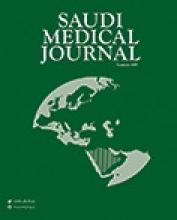Abstract
OBJECTIVE: To study the appropriate method of diagnosis and management in adult intussusception (AI) focusing on the clinical manifestations, diagnostic tools, and management of this rare disease.
METHODS: This retrospective study reviewed and analyzed the demographic data, clinical features, diagnosis, management, and pathology reports of all adult patients (18 years of age and older) with a diagnosis of intussusception admitted to Sohag University Hospital, Sohag, Egypt, and Najran Armed Forces Hospital, Najran, Kingdom of Saudi Arabia (KSA) from January 2004 to August 2012.
RESULTS: From 2004-2012, 14 patients with AI were diagnosed and treated. Ages ranged from 22-63 years. Ten patients (71.4%) were males. Thirteen patients (92.9%) presented with abdominal pain. All patients were diagnosed after a CT scan, and confirmed at laparotomy. The lead point was found in all, except for 2 patients. Ileo-ileal and jejuno-jejunal intussusceptions represented most of our cases (64.3%), followed by ileocolic (28.5%), and colocolic (7.1%). The most common causes were Peutz-Jeghers polyps (5 cases), submucosal lipoma (2), and malignancy (2). Surgery was the treatment option in all except one patient. Postoperative complications occurred in 3 cases (21.4%). One patient died 28 days postoperatively due to septic shock and multiorgan failure.
CONCLUSION: Owing to its rarity, AI needs a high index of suspicion especially in patients attending ERs with recurrent abdominal pain. A CT scan is of prime importance in the diagnosis, and surgical treatment is the preferred method of management.
- Copyright: © Saudi Medical Journal
This is an open-access article distributed under the terms of the Creative Commons Attribution-Noncommercial-Share Alike 3.0 Unported, which permits unrestricted use, distribution, and reproduction in any medium, provided the original work is properly cited.






